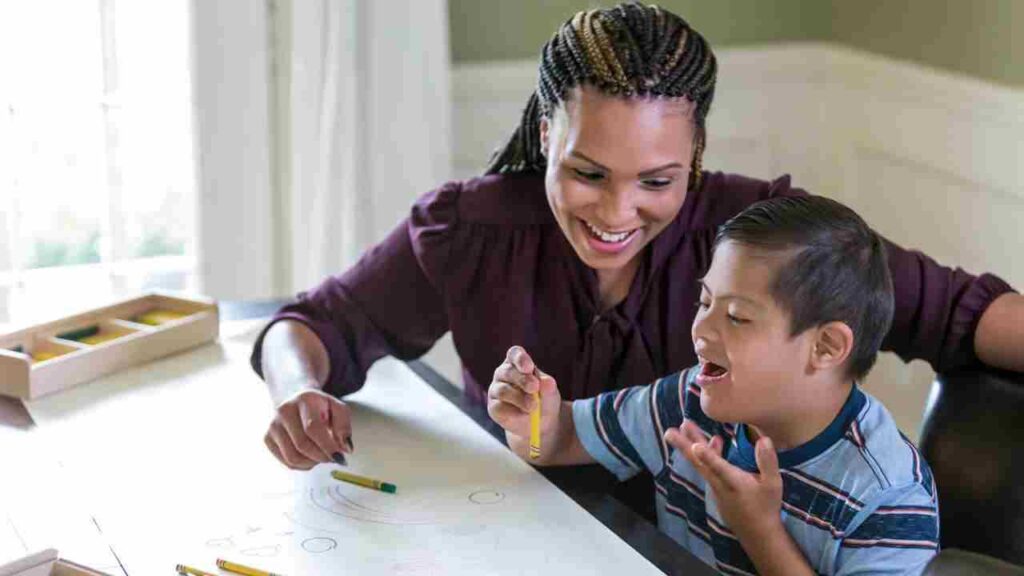Effective collaboration between families and professionals can lead to improved communication, better decision-making, and increased trust. It can also help to prevent misunderstandings or conflicts that may arise when working in isolation.
However, collaboration can be challenging, especially when dealing with complex issues related to special needs. In this blog post, we will discuss strategies for effective collaboration, challenges that may arise when collaborating with families of children with special needs, tips for building positive relationships with families, and examples of successful collaboration between families and professionals.
By the end of this post, you will have a better understanding of how to collaborate effectively with families of children with special needs and overcome any challenges that may arise.
Strategies for Effective Collaboration
Collaboration between families and professionals is essential in ensuring the best outcomes for children with special needs. However, effective collaboration requires more than just working together. It involves establishing open communication, setting goals together, and respecting cultural differences.
1. Establishing Open Communication
Open communication is the foundation of effective collaboration. It allows families and professionals to share information, provide feedback, and work towards common goals. Active listening is an essential component of open communication. Professionals should listen carefully to families’ concerns, questions, and ideas without judgment or interruption.
Sharing information is another essential part of open communication. Professionals should keep families informed about their child’s progress, any changes in treatment plans, and upcoming appointments or evaluations. Families should also be encouraged to share information about their child’s strengths, needs, and preferences.
Providing feedback is the final component of open communication. Professionals should ask for feedback from families on how they can improve their services or support. Families should also be encouraged to provide feedback on their experiences with the professional team.
2. Setting Goals Together
Collaborating on setting goals helps ensure that everyone involved has a shared understanding of what they are working towards. Identifying strengths and needs is the first step in setting goals together. Professionals should work with families to identify their child’s strengths and needs in various areas such as academics, social skills, behavior management, etc.
Creating a plan of action is the next step in goal-setting collaboration. The plan should include specific objectives that are measurable and achievable within a reasonable timeframe. The plan should also include strategies for achieving those objectives such as specific interventions or therapies.
Monitoring progress is the final step in goal-setting collaboration. Regular check-ins allow professionals and families to assess progress toward meeting objectives and make any necessary adjustments to the plan.
3. Respecting Cultural Differences
Cultural differences can impact how families perceive their child’s special needs as well as how they interact with professionals. Understanding cultural values is essential in building trust with families from diverse backgrounds.
Avoiding stereotypes is another important aspect of respecting cultural differences. Stereotyping can lead to misunderstandings that negatively impact collaboration between professionals and families from diverse backgrounds.
Collaborating with interpreters can help bridge language barriers that may arise when working with families who do not speak English fluently.
Read also: How to Address the Emotional Aspects of Disabilities in Children
Challenges in Collaboration
Collaborating with families of children with special needs can be a challenging task. The first challenge that professionals face is the lack of trust from families. Parents may have had negative experiences with professionals in the past, which makes it difficult for them to trust new professionals. To overcome this challenge, professionals must establish rapport and build trust by listening to parents’ concerns, being transparent about their intentions and actions, and following through on commitments.
Another challenge that arises in collaboration is communication barriers. Professionals must communicate complex information to parents who may not have a background in healthcare or education. This can lead to misunderstandings and frustration for both parties. To overcome this challenge, professionals should use clear language, avoid jargon, and provide written materials or visual aids when possible.
Differing expectations between families and professionals can also create challenges in collaboration. Families may have different priorities or goals than the professional team working with their children. It’s important for professionals to understand and respect these differences while still advocating for what they believe is best for the child. Open communication about expectations and priorities is key to finding common ground.
Read also: Strategies for Helping Children with Communication Difficulties
Tips for Building Positive Relationships with Families
Building positive relationships with families of children with special needs is crucial for effective collaboration. Here are some tips to help professionals establish trust and rapport:
- Demonstrate Empathy: Families may feel overwhelmed, frustrated, and stressed when dealing with their child’s special needs. It’s important to show empathy by listening actively and acknowledging their concerns. Professionals can also share personal stories or experiences that demonstrate understanding.
- Be Respectful: Respecting the family’s culture, beliefs, and values is essential for building a positive relationship. Professionals should avoid making assumptions or judgments about the family’s lifestyle or choices. Instead, they should ask open-ended questions to gain a better understanding of the family’s perspective.
- Be Available and Responsive: Being available and responsive to families’ needs shows that professionals care about their concerns. Professionals should respond promptly to phone calls or emails, provide regular updates on the child’s progress, and offer support during difficult times.
By following these tips, professionals can establish positive relationships with families of children with special needs. When families feel heard, respected, and supported, they are more likely to collaborate effectively with professionals in achieving their child’s goals.
Read also: How to Help Children with Disabilities to Thrive in the Classroom
Examples of Successful Collaboration
When families and professionals collaborate effectively, the results can be life-changing for children with special needs. One example of successful collaboration is through Individualized Education Program (IEP) meetings.
These meetings bring together parents, educators, and other professionals to develop a personalized plan for the child’s education. By working together to identify the child’s strengths and needs, as well as setting goals and determining necessary accommodations or modifications, IEP meetings can lead to significant progress in a child’s academic performance.
Another example of successful collaboration is through collaborative healthcare teams. Children with special needs often require care from multiple healthcare providers, such as doctors, therapists, and social workers. When these providers work together to share information and coordinate care plans, it can improve the overall quality of care for the child. This type of collaboration can also help ensure that each provider has a complete understanding of the child’s medical history and current treatment plan.
Community support programs are another example of successful collaboration between families and professionals. These programs provide resources and services to families of children with special needs, such as respite care, support groups, and recreational activities. By partnering with community organizations and professionals who specialize in serving individuals with disabilities, families can access valuable resources that may not be available otherwise.
Read also: Building Strong Relationships with Children with Disabilities
Conclusion
In conclusion, collaborating with families of children with special needs is crucial for their overall well-being and success. Effective collaboration requires a partnership between professionals and families, where both parties are valued for their unique perspectives and expertise. By implementing strategies such as active listening, clear communication, and mutual respect, professionals can build positive relationships with families that facilitate collaboration. However, challenges such as cultural differences, language barriers, and conflicting priorities may arise. It is important to acknowledge these challenges and work together to overcome them in a respectful and empathetic manner.
Through successful collaboration, families can become advocates for their children’s needs while professionals can provide the necessary support to help them achieve their goals. The benefits of collaboration extend beyond the immediate outcomes for the child; it also fosters a sense of trust and respect between families and professionals that can lead to long-term partnerships.






